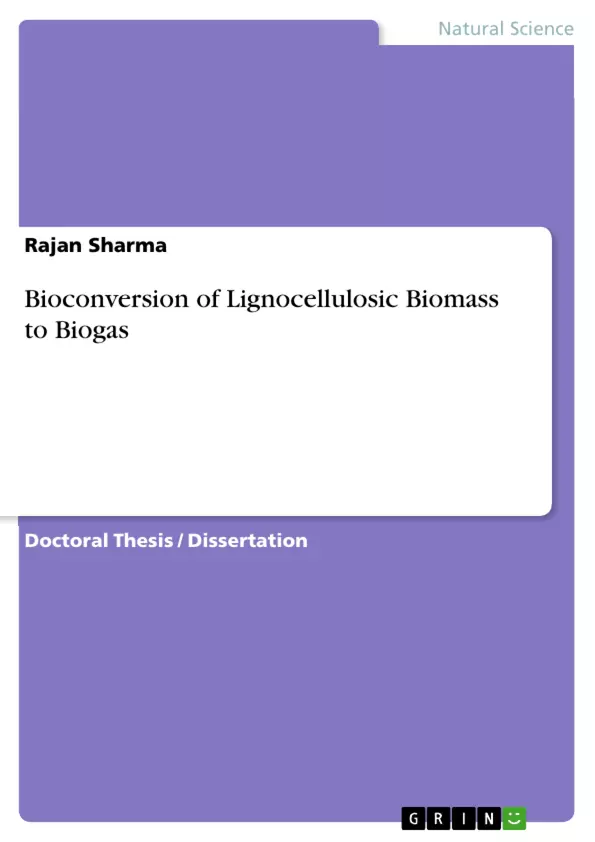The aim of the present study is to investigate the optimum pretreatment method and performance characteristics of anaerobic digestion of lignocellulosic biomass for biogas production in batch mode. To assess the potentiality towards biogas production, three different types of biomasses were collected and characterized. Based on the results obtained from the characterization, three different lignocellulosic biomasses viz sugarcane bagasse, wheat straw and rice husk were selected, upon which small scale anaerobic digestion was performed. In this research, therefore, an optimal achievement of the lignocellulosic plant has been evaluated in the pretreatment impact (physical, chemical and biological) and multiple biogas manufacturing parameters. The pretreatment method focused on removal of lignin content by applying different alkaline and acid condition and then anaerobic digestion of pretreated biomass (WS, RH, and SB).
Inhaltsverzeichnis (Table of Contents)
- Abstract
- Chapter 1: Introduction
- 1.1 Biogas production from lignocellulosic biomass
- 1.2 Advantages of biogas production
- 1.3 Challenges in biogas production
- 1.4 Objectives of the study
- Chapter 2: Literature Review
- 2.1 Biomass composition and properties
- 2.2 Anaerobic digestion process
- 2.3 Pretreatment methods for lignocellulosic biomass
- 2.4 Biogas production from various biomass sources
- Chapter 3: Materials and Methods
- 3.1 Biomass collection and characterization
- 3.2 Pretreatment methods
- 3.3 Anaerobic digestion setup and operation
- 3.4 Biogas analysis
- 3.5 Statistical analysis
- Chapter 4: Results and Discussion
- 4.1 Characterization of lignocellulosic biomass
- 4.2 Effect of pretreatment on biomass digestibility
- 4.3 Biogas production from pretreated biomass
- 4.4 Kinetic studies of anaerobic digestion
- 4.5 Optimization of biogas production
- Chapter 5: Conclusions
Zielsetzung und Themenschwerpunkte (Objectives and Key Themes)
The main objective of this thesis is to investigate the feasibility and optimize the process of biogas production from lignocellulosic biomass through anaerobic digestion. This research focuses on the impact of different pretreatment methods on the digestibility of lignocellulosic biomass and the subsequent biogas production.
- Bioconversion of lignocellulosic biomass to biogas
- Anaerobic digestion process and its optimization
- Pretreatment methods for improving biomass digestibility
- Biogas production from various lignocellulosic sources
- Kinetic studies of anaerobic digestion
Zusammenfassung der Kapitel (Chapter Summaries)
This section will provide an overview of the key themes and findings presented in each chapter of the thesis. It will explore the various aspects of lignocellulosic biomass conversion to biogas through anaerobic digestion, including the characterization of biomass, the effect of pretreatment methods on digestibility, and the optimization of biogas production.
- Chapter 1: Introduction - This chapter introduces the topic of biogas production from lignocellulosic biomass, highlighting its advantages and challenges. It also outlines the objectives of the study.
- Chapter 2: Literature Review - This chapter provides a comprehensive review of existing literature on biomass composition, anaerobic digestion, pretreatment methods, and biogas production from various sources. It also discusses the relevant research findings and methodologies used in previous studies.
- Chapter 3: Materials and Methods - This chapter details the materials used, the methods employed, and the experimental setup for the study. It describes the biomass collection and characterization procedures, pretreatment methods, anaerobic digestion setup, biogas analysis techniques, and statistical analysis methods used to analyze the data.
- Chapter 4: Results and Discussion - This chapter presents the results of the experimental studies, including the characterization of lignocellulosic biomass, the impact of pretreatment methods on biomass digestibility, and the biogas production from pretreated biomass. The chapter also discusses the kinetic studies of anaerobic digestion and the optimization of biogas production. It analyzes the data and provides insights into the factors affecting biogas production from various lignocellulosic sources.
Schlüsselwörter (Keywords)
The primary keywords and focus topics of this thesis are lignocellulosic biomass, anaerobic digestion, biogas production, pretreatment methods, biomass digestibility, kinetic studies, and optimization. The research focuses on the conversion of various types of lignocellulosic biomass, such as sugarcane bagasse, wheat straw, and rice husk, into biogas through efficient anaerobic digestion processes. The research also explores the impact of different pretreatment methods on the digestibility of biomass and the subsequent biogas production.
- Quote paper
- Dr. Rajan Sharma (Author), 2020, Bioconversion of Lignocellulosic Biomass to Biogas, Munich, GRIN Verlag, https://www.grin.com/document/1372897



